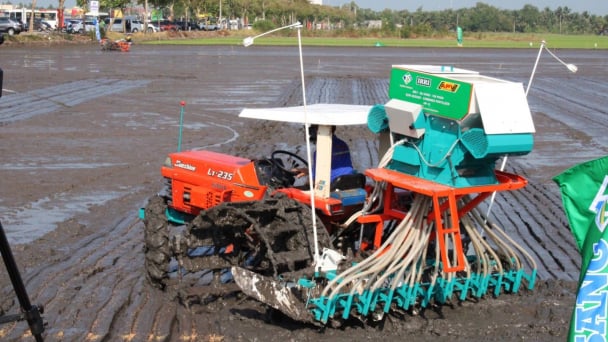May 21, 2025 | 00:08 GMT +7
May 21, 2025 | 00:08 GMT +7
Hotline: 0913.378.918
May 21, 2025 | 00:08 GMT +7
Hotline: 0913.378.918

Researchers unveil a plant gene mutation that enhances symbiosis with soil microbes, offering sustainable solutions to reduce fertilizer dependency. CREDIT: CC BY-SA 4.0.
Beneficial relationships between plants and soil microbes play a critical role in agriculture, providing sustainable solutions to reduce dependency on synthetic fertilizers. Researchers have uncovered a genetic mechanism in plants that could revolutionize how crops utilize nutrient-rich partnerships with soil microbes.
These findings promise to mitigate environmental harm caused by excessive fertilizer use and open new avenues for sustainable farming practices.
Central to this discovery is the role of a plant gene in calcium signaling pathways. Calcium oscillations in root cell nuclei are crucial for the establishment of endosymbiotic relationships between plants and beneficial microbes.
A mutation in the S1 helix of the cyclic nucleotide-gated channel (CNGC) 15 gene was found to enhance these partnerships. This mutation autoactivates CNGC15, generating low-frequency calcium oscillations even without external microbial signals.
Researchers demonstrated that the mutation in legumes like Medicago truncatula significantly boosted symbiosis with nitrogen-fixing bacteria and arbuscular mycorrhizal fungi (AMF). These microbes provide plants with essential nutrients like nitrogen and phosphorus in exchange for sugars.
Importantly, the CNGC15 gain-of-function mutation (CNGC15GOF) enhances the efficiency of these partnerships in farming conditions, where nutrient-rich soils typically inhibit such natural alliances.
The mutation—a substitution of a conserved proline residue—alters the structural dynamics of the CNGC15 protein. Normally, the protein requires external signals to activate calcium oscillations, but the mutation bypasses this requirement.
By introducing a kink in the transmembrane helices, the mutation enables the calcium channel to open autonomously, triggering calcium oscillations essential for symbiosis. This finding provides a deeper understanding of how plants regulate these crucial interactions.
To understand this process, scientists used cryo-electron microscopy and advanced modeling tools. They observed that the movement of transmembrane helices induced by the mutation enables the channel to remain active.
This autoactivation mechanism aligns with findings that DMI1, another protein essential for calcium oscillations, acts as a pacemaker to regulate oscillation frequency. The interplay between DMI1 and CNGC15GOF was shown to fine-tune calcium signaling, promoting efficient symbiotic responses.
DMI1 interacts with CNGC15 at the nuclear envelope, modulating its activity. Researchers found that calcium binding to DMI1’s C-terminal domain is critical for maintaining the frequency of calcium oscillations. Mutations in DMI1’s calcium-binding pockets disrupted its ability to regulate CNGC15GOF, demonstrating the importance of this interaction.
In plants lacking functional DMI1, the autoactivation of CNGC15GOF still produced calcium oscillations, though at a lower frequency. This highlights the independent role of CNGC15GOF in initiating symbiosis.
The study, published in the journal, Nature, also revealed how calcium oscillations influence plant metabolism. These oscillations regulate the production of flavonoids—compounds that enhance microbial colonization.
Low-frequency oscillations induced by CNGC15GOF were shown to increase flavonoid levels, creating a more hospitable environment for beneficial microbes. This discovery connects the molecular mechanisms of calcium signaling to broader physiological changes in plants.
Field trials with wheat confirmed the potential of this mutation beyond legumes. Wheat with the CNGC15GOF mutation exhibited increased colonization by nitrogen-fixing bacteria and AMF, leading to improved nutrient uptake. This enhancement translated to greater shoot dry weight and improved nutrient content, demonstrating the mutation’s effectiveness in boosting crop yields under real-world conditions.
The implications for sustainable agriculture are profound. Enhanced symbiosis reduces the need for synthetic fertilizers, which are costly and environmentally damaging. Excessive fertilizer use has been linked to water pollution, soil degradation, and greenhouse gas emissions. By leveraging the natural partnerships between plants and microbes, farmers can achieve higher yields while minimizing ecological impact.
Dr. Myriam Charpentier, who led the study, emphasized the broader significance of these findings. “Our discovery contributes to fundamental research on calcium signaling while offering practical solutions for sustainable agriculture. It’s exciting that a single mutation can have such far-reaching implications for crop production,” she said.
Beyond improving yields, the CNGC15GOF mutation aligns with global efforts to develop climate-resilient crops. As climate change intensifies, ensuring food security requires crops that can thrive in diverse conditions. The enhanced nutrient acquisition facilitated by CNGC15GOF equips plants to withstand nutrient-poor soils and environmental stressors, making this discovery a vital tool for future agriculture.
This research also advances our understanding of calcium signaling in plants. Calcium oscillations were shown to regulate the production of flavonoids, which play a critical role in facilitating symbiotic interactions. The frequency of these oscillations determines the specificity of the plant’s response.
High-frequency oscillations activate endosymbiotic gene expression, while low-frequency oscillations modulate phenylpropanoid pathways, influencing metabolic changes.
The study’s findings build on previous research into the molecular mechanisms of endosymbiosis. Scientists have long known that calcium signaling in root cell nuclei is essential for symbiotic partnerships. However, this study decodes the specific role of calcium oscillations, revealing how they govern interactions with nitrogen-fixing bacteria and AMF. This deeper understanding could inform future strategies to enhance these partnerships in a wide range of crops.
The CNGC15GOF mutation represents a significant step toward integrating endosymbiosis into modern farming systems. By enhancing the natural nutrient-acquisition abilities of crops, this approach reduces reliance on inorganic fertilizers and supports environmental conservation. The findings align with global efforts to reduce agricultural emissions and improve soil health.
Moreover, the study highlights the importance of fundamental science in addressing global challenges. Decoding the molecular mechanisms underlying plant-microbe interactions paves the way for innovative solutions to food security and environmental sustainability.
As researchers continue to explore the potential of genetic modifications like CNGC15GOF, the agricultural sector stands to benefit from more efficient and eco-friendly farming practices.
The practical applications of this research extend beyond legumes and wheat. The principles underlying CNGC15GOF could potentially be applied to other crops, broadening the impact of this discovery.
Developing high-yielding, disease-resistant crops that also exhibit efficient nutrient assimilation is a key goal for sustainable agriculture. This study represents a significant milestone in achieving that vision.
In summary, the discovery of the CNGC15GOF mutation offers a groundbreaking approach to sustainable farming. By enhancing symbiotic interactions, it reduces the need for harmful fertilizers and boosts crop resilience.
This innovation exemplifies how scientific research can address pressing global challenges, offering hope for a greener, more sustainable future.
thebrighterside

(VAN) In 2024, over 295 million people across 53 countries and territories faced acute hunger—an increase of almost 14 million people compared to 2023, while the number of people facing catastrophic levels of hunger reached a record high.

(VAN) World Environment Day 2025 (June 5) carries the theme 'Beat Plastic Pollution' continuing to emphasize the global urgency of addressing the plastic waste crisis.

(VAN) This was the assessment shared by experts at the workshop titled 'Assessing the Role and Potential of Low-Emission Rice Production Systems in Vietnam,' held on the morning of May 19.

(VAN) Cai Rong Port is the fisheries control center of Quang Ninh, helping to monitor fishing vessels, combat IUU fishing, and remove the EC's 'yellow card'.

(VAN) The German Agricultural Society (DLG) explores the possibility of establishing a mechanization service center in Vietnam’s Mekong Delta to support farmers in accessing and utilizing advanced machinery.

(VAN) On May 16, the Department of Water Resources Management, in collaboration with the Food and Agriculture Organization of the United Nations (FAO), held a signing ceremony for the GEF-8 project document.

(VAN) Food safety, mechanization, vocational training, and market opening are key areas of cooperation expected between the Vietnamese Government and the Federal Republic of Germany.